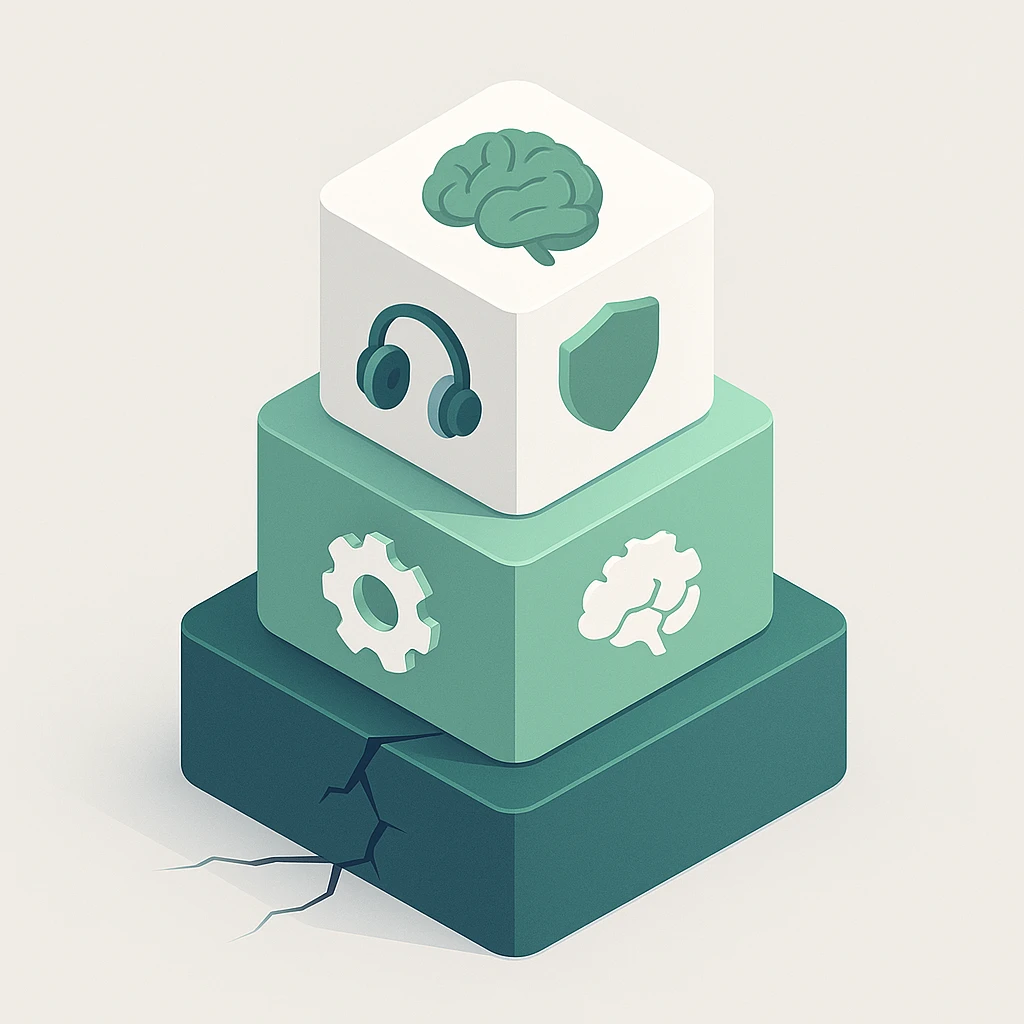The “Weapons of Focus” You’ll Gain from This Article

The factors that sabotage your focus don’t always show up in the same form. Sometimes it’s physical noise. Sometimes someone talks to you. Sometimes a stray worry or association hijacks your mind. And sometimes, you’re not even sure what you should be doing in the first place, so the farther you go, the more lost you feel.
Turning these scattered on-the-ground events into one shared vocabulary and dealing with them using one shared way of thinking is the starting point of productivity. The Flowtime Technique is a flexible time design that says “work as long as your focus lasts, then rest at the break.” But to run it flexibly, you must understand why focus breaks and avoid misprioritizing countermeasures.
By the time you finish this article, you’ll be able to label your own interruptions in a short phrase and immediately decide where to intervene first.
The goal is not to “reduce all interruptions to zero.” That’s unrealistic and too costly. The goal is rather to minimize the time and errors before you return to the task. Interruption isn’t the enemy; it’s an object of design, a matter of how you handle it.
Learn to Spot the Three Types of Focus-Breaking Interruptions

As a premise, this article thinks about interruptions in three layers.
① Interruptions Caused by Lack of Foundational Preparation
The first is preparation. These are task interruptions that arise from gaps in design or prep—insufficient information, ambiguity about what to do, or a lack of decision criteria.
Structurally, this is the foundation: when you don’t know exactly which task you’re tackling, interruptions amplify. That’s the recurring pattern I’ve seen on the ground.
For example, frequent check-ins from colleagues might look like interpersonal interruptions, but if the foundation is weak, it may actually be because what to do isn’t clear and who decides what is ambiguous, so you’re stuck in a state of “can’t proceed without confirming.” Or it could be that you yourself don’t really understand your own task.
When materials are scattered and you can’t reach the information you need, the root cause is a failure of organization.
Interruptions born of lack of preparation often come with the feeling that the more you proceed, the more lost you become. Time passes without traction; you keep going back to reread; you keep thinking the same thoughts. If you notice those signs, one of your feet is already in the swamp of structure.
② Interruptions That Press In from the Outside
The second is the external layer. This includes all factors coming from outside you—environmental noise, visual stimuli, device notifications, and the like.
A sudden call, a chime, something moving at the edge of your vision, nearby conversations, changes in air conditioning or lighting. Whenever external forces act on your attention—even for a split second—your awareness is pulled outward.
What matters here is that external interruptions are amenable to batch handling. Gaze, posture, sound, light—short adjustments can drastically reduce their impact.
This includes interpersonal interruptions. People dynamics require care, but the principle is the same: they’re forces from outside. The difference is whether you can use signals and prefaces, and the need to protect the relationship.
③ Interruptions That Arise Inside the Mind
The third is the internal layer, i.e., interruptions that originate within you. Sudden associations, anxiety about unfinished items, attention drifting from boredom, loops of self-evaluation—these inward detours of attention belong here.
Internal factors are the hardest to grasp and the most underestimated. Sudden chains of thought, nagging incompletions, fears about evaluation, rising boredom. They’re invisible from the outside, yet they occur continuously as an internal dialogue.
The tricky part is that internal interruptions arrive with the most persuasive justifications.
“Just in case, I should check that document too.” “I’m uneasy about the quality bar, so I’ll make another version.” Wearing the mask of seemingly sound judgment, they lure your attention off the main road.
Here, putting things into words is vital. Can you, right before acting, summarize in one sentence “what you’re about to do, toward what outcome, and from which first step”? If you can’t, it’s likely you’re not at the helm.
What Order Should You Intervene In?

So, in what order should you respond? My criterion is clear.
① First, Fortify the Foundation
First, fix the structure. Structure has a wide blast radius. If what to do is ambiguous, your focus won’t last in any task. Gaps in task design boomerang as costs in later stages.
Therefore, before starting a task, spend a short check to solidify the frame—“purpose,” “decision criteria,” and “dependencies.” If you start getting lost mid-task, pause and update the definition of the question.
Concretely:
- Organize in your head: “What is the goal of this work?”
- Narrow down: “What are the completion criteria?”
- List out: “Whose confirmation is needed?” “What information is missing?”
② Next, Tune the External Stimuli
Second, tidy up the external factors that break focus. Reset your gaze, adjust your posture, block noise, clear the visual field. This is an area where small, yellow-light tweaks go a long way.
Concretely:
- Direct your gaze far away, e.g., out the window, and hold it for 15 seconds
- Adjust your chair height or where you sit
- Use earphones or noise canceling to block sound
- Remove unnecessary items from your visual field on the desk
③ Then, Handle People’s Interruptions
Third, deal with interpersonal factors using signals and prefaces. Be brief and sincere, and name a concrete time when you’ll return.
Concretely:
- “I’m in a focus block now—let me come by again at 2:00 p.m.”
- Say a specific time: “I’ll message you in 30 minutes.”
- Set chat status or calendar entries to “Focus Time”
④ Finally, Use Words to Steer Your Mind Back
Lastly, the internal factors. For the internal layer, embed re-entry cues as a routine. One sentence → three breaths → two minutes—use this in place of wavering.
Related article: Flowtime Technique Restart Cues | How to Restore Focus with “1 Sentence → 3 Breaths → 2 Minutes”
Concretely:
- Declare in one line: “Next, I’ll write three section headings.”
- Take three deep breaths to release tension
- Spend two minutes on a simple related task (e.g., sorting headings) to reacquire context
The logic of priority is simple: act in the order of easier to control and broader impact. Structure has the largest impact area. External factors are easy to control. Interpersonal factors can be made controllable by agreement. Internal factors are hard to control, but can be handled sufficiently with words and routine. That’s why this order.
How to Apply This with the Flowtime Technique
Here’s how to ground this in the Flowtime Technique. Flowtime isn’t a fixed-duration timer. You keep going as long as focus continues and rest at the break. The break is measured not by “time” but by signals.
Signals appear across three layers—body, cognition, and behavior.
- Bodily signals: gaze drifting, shallow breathing, tense shoulders
- Cognitive signals: more rereading, delayed decisions, looping the same thoughts
- Behavioral signals: aimless tab-hopping, scrolling the same section, checking email
Yellow Light: What to Do When Early Warning Signs Appear
When these signals turn yellow—you can still proceed, but quality is starting to drop—insert small tweaks.
Yellow-light countermeasures:
- Move your gaze far away and change posture
- Fix the next step in one sentence (e.g., “Next, I’ll create three charts.”)
- If needed, insert a two-minute side task:
- Align the headings
- Write a three-line summary
- Tidy up reference materials
If you feel you can continue, carry on.
Red Light: What to Do When Focus Is Completely Broken
When it turns red—your actions are off, judgment is broken, and the drop in quality is obvious—step away without hesitation. Stepping away isn’t failure; it’s preparation to return with re-entry cues.
Red-light countermeasures:
- Declare one sentence for the next step (“When I’m back, I’ll add two case examples.”)
- Take three breaths to release excess tension
- Do a two-minute warm-up to reconstruct context:
- Reread the part you were just working on
- Rehearse the overall flow in your head
- Vividly imagine the next steps
Tune the line between yellow and red according to your bodily sense. In about two weeks, you can build your own calibration.
Let’s Work Through Real Situations
From here, we’ll solidify how to use prioritization with concrete examples.
Case 1: When You’re Generating Ideas
Consider a writer drafting the skeleton of a new proposal. Once they start reading materials, interesting points keep popping up; tabs multiply; the outline sketch barely progresses.
What’s happening:
On the surface, it looks like the lure of links and unstoppable associations. But the root is structure. The question is loosely defined and there are no decision criteria.
Order of response:
-
Redefine the structure (top priority)
- Summarize your thesis in one sentence: “This proposal exists to △△ in order to ○○.”
- Limit decision criteria to three: “(1) Feasibility, (2) Impact, (3) Cost”
- Bound your references: “Core knowledge up to three articles; five cases max”
-
Tidy the external
- Close tabs and keep only what’s needed
- Set a timer to cap “reading” at 30 minutes
-
Organize the internal
- Before starting, declare: “Next, I’ll write the three top-level headings.”
Once structure is set, external stimuli and internal associations are absorbed into the main track, and yellow-light tweaks will often suffice.
Creative tasks are prone to a break at the moment you switch from expanding to narrowing. If you bridge that break with heading alignment or a three-line summary, the chance of falling into red drops dramatically.
Case 2: When Doing Routine Work
QA checks or reviews that follow set rules. Here, external noise and visual fatigue show up as slack in precision, and recurring mistakes increase.
Order of response:
-
Confirm structure
- Update the checklist to the latest version
- Record “how far you’ve completed”
-
Tidy the external (focus here)
- Insert a 15-second “gaze far away” break every 30 minutes
- Change posture (stand, change location, etc.)
- Read short snippets out loud to reset your sensory mode
-
Organize the internal
- When you feel the rush to “finish quickly,” declare in one sentence the next check item and its completion condition, then continue
Putting things into words is the most effective medicine for the internal layer. Adding just this at yellow often restores precision before you drop into red.
Case 3: When the Task Requires Hard Judgment
Prioritizing product features, hiring decisions, offering terms to a client. Interruptions here may look like internal wavering, but many stem from undefined decision criteria (structure).
What’s happening:
Debate goes in circles; materials increase; the conclusion doesn’t get closer.
Order of response:
-
Rebuild the structure (top priority)
- Write the decision question in one sentence: “Which should we prioritize, A or B?”
- Limit criteria to three: “(1) Revenue impact, (2) Feasibility, (3) Risk”
- Explicitly discard one side of the trade-off: “This time we’ll prioritize speed over perfection.”
-
Handle the interpersonal
- Briefly declare: “We’re prioritizing criteria definition now. In 30 minutes we’ll move to checking primary data.”
- By naming a concrete return time, you protect relationships while guarding your focus
-
Organize the internal
- The moment you sense wavering, switch to a two-minute side task
- Enumerate options and map them to the criteria to restore the skeleton of thought
Measures for When Focus Breaks in Meetings
Meetings may look like an external factor in this article’s framing, but in truth they’re one of the internal factors. A meeting is a venue for one of three roles—decision, sharing, or divergent exploration—yet it can also be a place where information unrelated to you flows, and it can be wedged between tasks, breaking your focus on what you were doing.
How to Reconnect Your Focus Before and After Meetings
The response is simple: use the 15 minutes before and after the meeting strategically. If 15 feels long, five will do.
15 minutes before the meeting:
- Summarize where you are now in three lines
- Fix the next step in one sentence (“When I’m back, I’ll create three charts.”)
15 minutes after the meeting:
- Write down three decisions from the meeting
- Rebuild your own first step in writing (“I’ll start with ○○.”)
On days with back-to-back meetings, even 10 minutes between them is fine. Create an intentional intermittent flow; place a nucleus of progress in another task, however small. This way, even amid the big waves of meeting-induced interruptions, your own flow won’t snap.
How to Embed This into Your Day
Here is a procedure to embed interruption countermeasures into a day.
Before Starting Work (60 seconds)
Use this for structure checks.
- Can you state the purpose in one sentence?
- Are the decision criteria standing at three or fewer?
- Where are the dependency bottlenecks?
If you get stuck here, spend the first five minutes shoring up structure to build readiness to run fast.
During Work (Continuously)
Listen for signals.
- Bodily unease
- Cognitive stickiness
- Behavioral drift
When the light turns yellow:
- Insert small tweaks of gaze, posture, and one sentence
If you drop into red:
- Step away and return with re-entry cues
Before Ending Work (30 seconds)
Plant a one-sentence next step to bridge to your future self.
- “First thing tomorrow morning, I’ll start with ○○.”
- “Next session, I’ll finish △△.”
Once routinized, this speeds you up—time spent wavering is replaced by designed action.
A Weekly Review Procedure
A weekly review doesn’t need to be heavy. The lighter it is, the more sustainable. What I recommend is just three lines of notes.
Three Questions for the Weekly Review
- What kind of interruption cropped up most this week?
- Where did the longest interruption happen?
- Which tweak worked best?
Write only this and feed it into the next week’s priorities.
Examples of Feeding into the Next Week
- If “structure” dominates: devote just two extra minutes to pre-start checks next week
- If “interpersonal” dominates: add one more variant to your signals/phrasing
- If “internal” dominates: refine your one-sentence re-entry cue
What matters is keeping the unit of improvement small. Small improvements almost certainly succeed; success builds confidence; confidence creates stickier focus.
Frequently Asked Questions
Q1: What should I do when task interruptions are increasing?
Answer: Return to the purpose.
If your task has stalled or your head hasn’t switched gears—whenever the task halts—organizing why you are doing this task works wonders.
Concrete steps:
- Briefly check the task definition, decision criteria, and dependencies
- If anything is missing, make your first move there
- If it still doesn’t budge, start by organizing the easier-to-control external factors
This usually restores the flow of focus.
Q2: How do I get my focus back when emergencies keep happening?
Answer: Decide your re-entry routines and rules in advance.
Emergency responses can easily break your personal flow. The key is to have a routine for returning to your own work after the emergency ends.
Three response patterns:
-
If immediate emergency action is required
- Spend 30 seconds to think through “what to do” for the current task
-
If the emergency can be deferred
- Tell the other party a specific time (“I’ll get back to you at 2:00 p.m.”)
-
If the emergency can be delegated
- Hand off with responsibility and a deadline (“○○, please handle this by Friday 5 p.m.”)
- Eliminate room for misunderstanding
There are unavoidable stretches with a run of emergencies, but ride out the wave and it should settle.
Today’s Wrap-Up
Everyone experiences focus breaks from task interruptions. They’re not evil; they’re a matter of handling.
Remember the Three-Order Response
- Make preparation thorough
- Tidy external factors in a batch
- Tame internal factors with routines
How to Use the Flowtime Technique
- Measure task breaks and rest moments not by time but by various signals
A Weekly Touchpoint
Adjust priorities with a weekly review.
That’s all it takes to turn the same hours into an opportunity to raise the quality of your tasks. Focus isn’t protected by willpower; it’s protected by design.
One last implementation note. No matter how good a method is, whether it sticks in the first two weeks determines how it becomes a habit thereafter.
At FlowTime - Focus Timer, you’ll find timer features to sustain focus and an automatic calculation of break length based on your work sessions. It automatically records how long you focused so you can review it later—give it a try.
Reference
- Gloria Mark, Daniela Gudith, Ulrich Klocke. "The Cost of Interrupted Work: More Speed and Stress." CHI 2008.
- Victor M. González, Gloria Mark. "Constant, Constant, Multi-tasking Craziness: Managing Multiple Working Spheres." CHI 2004.
- Erik M. Altmann, J. Gregory Trafton. "Memory for Goals: An Activation-Based Model." Cognitive Science, 2002.
- Stephen Monsell. "Task switching." Trends in Cognitive Sciences, 2003.
- David E. Meyer, Jeffrey E. Evans, David E. Rubinstein. "Executive Control of Cognitive Processes in Task Switching." Journal of Experimental Psychology: Human Perception and Performance, 2001.
- Sophie Leroy. "Why is it so hard to do my work? The challenge of attention residue when switching between work tasks." Organizational Behavior and Human Decision Processes, 2009.
- Shamsi T. Iqbal, Eric Horvitz. "Disruption and Recovery of Computing Tasks: Field Study, Analysis, and Directions." CHI 2007.
- Brid O'Conaill, David Frohlich. "Timespace in the Workplace: Dealing with Interruptions." CHI 1995.
- Patricia Albulescu, Coralia Sulea. "Give me a break! A systematic review and meta-analysis on the efficacy of micro-breaks for increasing well-being and performance." PLOS ONE, 2022.
- David M. Cades, Deborah A. Boehm-Davis, et al. "What Makes Real-World Interruptions Disruptive? Evidence for the Role of Goals." Proceedings of the Human Factors and Ergonomics Society Annual Meeting, 2010.
